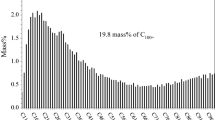An analysis is made of the characteristics and mechanisms of extraction with propane of heavy oils from the porous medium of the Jiang 37 Block, Daqing Oilfield (China), which is characterized by shallow depth of oil occurrence, a thin oil-bearing stratum, poor permeability, and high oil viscosity. The results show that propane has a strong heavy oil extraction capacity and that the solubility of propane in the oil and density and viscosity of the oil depend on pressure. It is shown by gas chromatography and IR spectroscopy that the composition of the oil changes during the propane extraction process: the content of light components increases and the content of heavy components decreases due to deasphalting.







Similar content being viewed by others
References
Fajun Zhao, Guangyun Wang, Si Ha, et al., Chemical Industry and Engineering Progress, 31, 304–309 (2012).
Jianyi Hu and Jiangyu Niu, Oil & Gas Geology, 15, 105–112 (1994).
Wenxin Zhong and Mingshung Chen, Oil Forum, 28, 18–23 (2008).
R. G. Moore, C. J. Laureshen, J. D. M. Belgrave, et al., Eleventh Ann. Heavy Oil and Oil Sands Tech. Symp. Alberta (1994).
R. M. Butler and D. J. Stephens, J. Canadian Petroleum Technology, 20, 90–96 (1981).
R. M. Butler and I. J. Mokrys, Ibid., 30, 97–106 (1991).
R. M. Butler and I. J. Mokrys, Ibid., 32, 56–62 (1993).
Bing Qin, Study on the Relationship between the Composition and Performance of Viscosity-Reducing Agent Used in the Viscous Crude Oil Recovery. Doctoral Thesis. Research Institute of Petroleum Processing. Beijing (2001).
C. Pierre, L. Barre, A. Pina, et al., Oil & Gas Science and Technology, 59, 489–501 (2004).
A. B. Bazyleva, M. D. Anwarul Hasan, et al., J. Chemical & Engineering Data, 55, 1389–1397 (2010).
S. K. Das and R. M. Butler, J. Petroleum Science and Engineering, 21, 43–59 (1998).
A. R. Oduntan, Heavy Oil Recovery Using the VAPEX Process: Scale-Up and Mass Transfer Issues. Doctoral Thesis. University of Waterloo. Waterloo (20010.
Reza Azin, Riyaz Kharrat, Cyrus Ghotbi, et al., J. Petroleum Science and Engineering, 60, 51–66 (2008).
Samane Moghadam, Morteza Nobakht, and Gu Yongan, Ibid., 65, 93–104 (2009).
S. Mobeen Fatemi and Riyaz Kharrat, Ibid., 75, 260–273 (2011).
Ali Yazdani and B. B. Maini, Energy & Fuels, 22, 535–544 (2008).
R. M. Butler and C. T. Yee, J. Canadian Petroleum Technology, 41, 31–40 (2002).
This study was conducted with the support of Major National Special Projects for Oil and Gas (Project No. 2011ZX05012-003) and the Open Foundation of the Key Laboratory of Enhanced Oil and Gas Recovery of the Ministry of Education.
Author information
Authors and Affiliations
Additional information
Translated from Khimiya i Tekhnologiya Topliv i Masel, No. 1, pp. 23 – 26, January– February, 2015.
Rights and permissions
About this article
Cite this article
Zhao, F., Liu, Y., Zhao, X. et al. Characteristics and Mechanisms of Solvent Extraction of Heavy Oils from Porous Media. Chem Technol Fuels Oils 51, 33–40 (2015). https://doi.org/10.1007/s10553-015-0572-2
Published:
Issue Date:
DOI: https://doi.org/10.1007/s10553-015-0572-2




